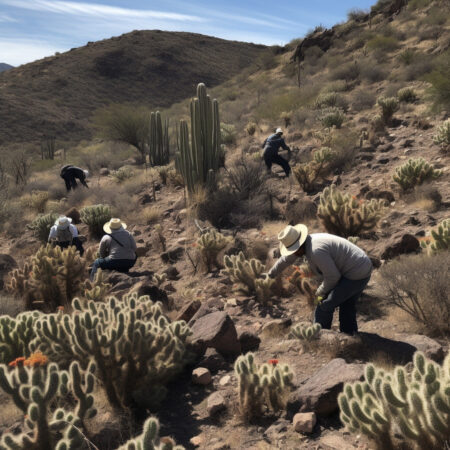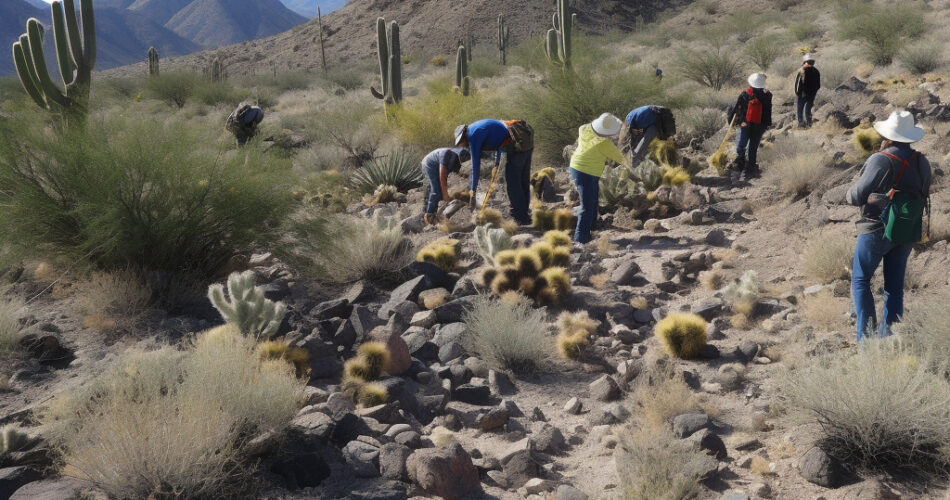Key Takeaways:
- Cactus habitats are vital for maintaining biodiversity and ecological balance.
- Cacti have unique adaptations to survive in arid environments and play a role in stabilizing soil and providing shelter.
- Habitat loss and invasive species pose significant threats to cactus habitats.
- Restoration techniques include habitat restoration strategies, natural regeneration, and community involvement.
- Successful restoration projects have occurred through cactus reintroduction and community involvement.
- Innovations like drone technology aid in monitoring and conservation efforts.
- Sustainable management practices, public awareness, and research are crucial for future prospects of cactus habitats.
The Importance of Cactus Habitats
Cactus habitats play a vital role in our ecosystem, providing numerous ecological benefits and serving as unique and important habitats for a wide range of wildlife. These habitats are found in various regions around the world, including deserts, grasslands, and even tropical rainforests. The preservation and restoration of cactus habitats are crucial for maintaining biodiversity and ensuring the overall health of our planet.
1. Ecological Significance of Cactus Habitats
Cactus habitats are incredibly diverse and support a wide array of plant and animal species. These habitats often have low precipitation levels and harsh environmental conditions, and cacti have adapted to survive in such extreme conditions. The presence of cacti in these habitats helps in stabilizing the soil, preventing erosion, and providing shade and shelter for other vulnerable plant species.
Additionally, cactus habitats also contribute to the ecological balance by acting as water catchments and reducing water run-off during rainfall events. They store water in their fleshy stems and utilize it during dry periods, thereby preventing water scarcity in the surrounding areas. This ability to store water is critical for the survival of not only other plant species but also various desert-dwelling animals.
2. Unique Adaptations of Cacti
Cacti are remarkable plants with unique adaptations that allow them to thrive in arid environments. One of the most notable adaptations of cacti is their ability to minimize water loss through specialized tissue structures known as succulence. These tissues store water, allowing cacti to survive extended periods of drought.
Cacti also have specialized root systems that are designed to maximize water absorption. Their shallow but extensive root systems enable them to quickly capture and absorb any available water, making the most of infrequent rainfall events. Some cacti also have spines that help protect them from herbivores and reduce water loss by providing shade and reducing airflow around the plant surfaces.
3. Threats to Cactus Habitats
Unfortunately, cactus habitats are facing numerous threats that jeopardize their survival. One of the significant threats to cactus habitats is habitat loss due to human activities such as urbanization, agriculture, and overgrazing. These activities lead to the destruction and fragmentation of cactus habitats, leaving the remaining populations vulnerable to further decline.
Invasive species are another threat to cactus habitats. Non-native plants and animals can disrupt the delicate balance of the ecosystem by outcompeting native species for resources and causing changes in the habitat structure. Invasive species often have a negative impact on cacti by outcompeting them for water, space, and nutrients, ultimately leading to a decline in cactus populations.
Restoration Techniques for Cactus Habitats
The restoration of cactus habitats is crucial for their long-term survival and the preservation of biodiversity. Several restoration techniques have been developed to address the various challenges faced by cactus habitats.
1. Habitat Restoration Strategies
Habitat restoration strategies aim to recreate or enhance cactus habitats that have been degraded or destroyed. These strategies involve actions such as removing invasive species, replanting native cacti, and restoring natural water flows. By restoring the habitat’s natural functioning, these techniques help create a suitable environment for cacti and other native species to thrive.
Restoration efforts can also involve the creation of artificial structures such as shade structures or microhabitats to provide additional protection to young cacti and increase their chances of survival. These structures mimic the natural environment and help create favorable conditions for cacti to establish themselves in restored habitats.
2. Natural Regeneration and Propagation
Natural regeneration and propagation are essential techniques for restoring cactus habitats. By allowing cacti to reproduce and disperse naturally, restoration efforts can ensure the long-term sustainability of cactus populations. This approach involves protecting existing cactus populations, facilitating their pollination, and dispersing their seeds.
Propagation techniques, such as tissue culture and seed banks, can also be employed to increase the number of cacti available for restoration projects. These techniques allow for large-scale production of cacti from a limited number of individuals, ensuring genetic diversity and increasing the chances of successful restoration.
3. Conservation Initiatives and Partnerships
Collaboration between various organizations, including government agencies, conservation groups, and local communities, is crucial for the successful restoration of cactus habitats. Conservation initiatives and partnerships can provide the necessary resources, expertise, and community involvement needed to implement restoration projects effectively.
These efforts can include educational programs, awareness campaigns, and capacity building to empower local communities to participate in conservation activities. By involving local communities in cactus habitat restoration, we not only enhance the success of these projects but also foster a sense of ownership and stewardship among community members.

Success Stories in Cactus Habitat Restoration
Despite the challenges faced by cactus habitats, there have been notable success stories in their restoration, showcasing the effectiveness of conservation efforts and providing hope for the future.
1. Cactus Reintroduction Projects
Several cactus reintroduction projects have been successful in restoring populations of threatened or endangered cacti. These projects involve collecting seeds or vegetative material from wild populations, propagating them in nurseries, and reintroducing them into their natural habitats.
One such example is the successful reintroduction of the Saharan cactus (Euphorbia balsamifera) in the Moroccan Sahara. This cactus was on the brink of extinction due to overgrazing and habitat destruction. Through a collaborative effort involving local communities and international organizations, the Saharan cactus population has been restored, ensuring its long-term survival.
2. Community Involvement in Restoration
Community involvement plays a crucial role in the successful restoration of cactus habitats. By engaging and empowering local communities, restoration projects can benefit from traditional ecological knowledge and ensure the long-term sustainability of restoration efforts.
An example of community involvement in restoration is the efforts of the Tohono O’odham Nation in Arizona, United States. The Nation has implemented a restoration program that focuses on conserving and restoring native cacti species. Through their traditional practices and knowledge, they have successfully restored cactus populations and created culturally significant habitats.
3. Innovations in Cactus Conservation
The field of cactus conservation has seen remarkable innovations that enhance the effectiveness of restoration efforts. One such innovation is the use of drone technology to survey and monitor cactus populations.
Drones equipped with high-resolution cameras and remote sensing capabilities can provide detailed information on the distribution, abundance, and health of cacti, enabling conservationists to make informed decisions regarding restoration priorities and interventions.
Future Prospects for Cactus Habitats
The preservation and restoration of cactus habitats are ongoing efforts that require long-term commitment and collaboration. Several key areas can influence the future prospects of these habitats.
1. Sustainable Management Practices
Implementing sustainable management practices is crucial for the conservation of cactus habitats. This includes managing land use, promoting sustainable agriculture practices, and regulating the collection and trade of cacti and their products.
By adopting sustainable practices, we can minimize the impact of human activities on cactus habitats and ensure the long-term viability of cactus populations.
2. Promoting Public Awareness and Education
Public awareness and education are essential for garnering support and promoting the conservation of cactus habitats. By raising awareness about the ecological importance of cacti and their habitats, we can inspire individuals to take action and support conservation initiatives.
Education programs, both within local communities and in schools, can help instill a sense of responsibility and foster a culture of environmental stewardship. Through education, we can empower future generations to actively participate in the preservation of cactus habitats.
3. Research and Conservation Priorities
Continued research is essential for understanding the complex dynamics of cactus habitats and developing effective conservation strategies. Research efforts should focus on studying the ecological relationships between cacti and other species, assessing the impacts of climate change on cactus habitats, and identifying potential restoration sites.
Conservation priorities should be based on scientific evidence and take into account the needs and characteristics of different cactus species. By prioritizing conservation efforts, we can allocate resources efficiently and maximize the impact of restoration projects.
In conclusion, the restoration of cactus habitats is crucial for maintaining biodiversity and preserving the ecological balance. By implementing effective restoration techniques, engaging local communities, and prioritizing conservation efforts, we can ensure the long-term survival of these unique and important habitats. With continued efforts and collective action, we can nurture nature’s resilience and secure a sustainable future for cactus habitats and the species that depend on them.
FAQ
Question: Why are cactus habitats important?
Cactus habitats play a vital role in our ecosystem, providing numerous ecological benefits and serving as unique and important habitats for a wide range of wildlife.
Question: What are some unique adaptations of cacti?
Cacti have unique adaptations that allow them to thrive in arid environments, such as succulence to minimize water loss, specialized root systems for water absorption, and spines for protection and reducing water loss.
Question: What are the threats to cactus habitats?
Cactus habitats face threats such as habitat loss due to urbanization and agriculture, as well as invasive species that disrupt the ecosystem and outcompete native plants for resources.
Question: What techniques can be used to restore cactus habitats?
Restoration techniques include habitat restoration strategies, natural regeneration, and community involvement to recreate or enhance cactus habitats that have been degraded or destroyed.
Question: How can community involvement contribute to cactus habitat restoration?
Community involvement is crucial in restoration efforts as it provides traditional ecological knowledge, support, and can empower local communities to participate in conservation activities.
Question: Can cactus populations be reintroduced successfully?
Yes, reintroduction projects have been successful in restoring populations of threatened or endangered cacti by collecting seeds or vegetative material from wild populations, propagating them in nurseries, and reintroducing them into their natural habitats.
Question: How can innovations like drone technology aid in cactus conservation?
Drones equipped with high-resolution cameras and remote sensing capabilities can provide detailed information on cactus populations, helping conservationists make informed decisions regarding restoration priorities and interventions.
Question: What can individuals do to support cactus habitat conservation?
Individuals can support cactus habitat conservation by adopting sustainable practices, promoting public awareness and education, and supporting research and conservation priorities.




Comments